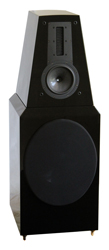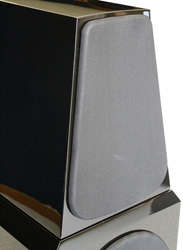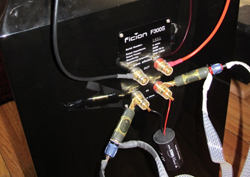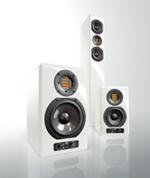
Introduction to the Eficion F300 Speaker
It’s hard to believe, but I first encountered the Eficion F300 loudspeaker almost four years ago, in the fall of 2008, at the Rocky Mountain Audio Fest. Then priced $2000 less than currently, the F300 so impressed Bob Walters, the new head of the Bay Area Audiophile Society, when he first heard it that he urged me to take a listen.
I too was mighty impressed with what I heard. As I wrote in my show blog for Stereophile, “I really loved the detail, control, and palpable, lifelike presentation the F300 brought to Cookie Marenco’s Blue Coast Records first hybrid SACD of all acoustic folk and blues… Everything was clean and lovely.
“On Trevor Pinnock’s Gramophone Award-winning recording of Bach’s Sixth and final Brandenburg, the speaker absolutely nailed the midrange of period instruments. Highs were a mite brittle, but that probably had to do with the cabling. Given the excellent way in which the F300 enables voices to hang in space, I resolved to eventually audition and review this speaker on my reference system.”
EFICION F300 LOUDSPEAKER SPECIFICATIONS
- Design: 3-way 4-driver, Ported
- Drivers: One 2.3″ x 0.3″ Ribbon Super Tweeter, One 5.1″ x 1.4″ Air Motion Transformer Tweeter, One 6.5″ Carbon Fiber Midrange, One 12″ Carbon Fiber Woofer
- MFR: 25 Hz – 40 kHz
- Sensitivity: 89dB/2.83V/1m
- Nominal Impedance: 8 Ohms
- Crossover: 110 Hz, 1.3 kHz
- Dimensions: 42.5″ H x 15.6″ W x 17″ D
- Weight: 158 Pounds/each
- MSRP: $16,900/pair USD
- Eficion
- SECRETS Tags: Speakers, Eficion, Floor-standing
It was at that time that I made the acquaintance of Peigen Jiang, who brings in the speaker from China. Based in Washington state, Peigen (or P.J. to some) helped design portions of the speaker, which is manufactured by Aurum Cantus.
A year later, at RMAF 2009, I discovered that further refinements to the Eficion F300 had produced “a more controlled and detailed sound.” I also was greatly impressed with how inserting Stillpoints Ultra SS equipment supports between the upper and lower modules of this two-module speaker, and using Stillpoints Ultra SS feet on the bottom of the cabinet, had added extra life, air and dimensionality to the sound, and improved bass control.
By October, 2010, when I returned to RMAF and wrote a blog about the excellent Eficion F250 loudspeaker, the Eficion F300 / Stillpoints Ultra SS combo had joined my reference system. We had initially considered the F250, but agreed that it would not have sufficient bass for a room its size. In one sense, that’s too bad. At the second, 2012 installment of T.H.E. Show Newport Beach, the F250, sounded wonderful paired with Z-Infinity customizable tube amplification.

The F300 remained in my system until June 2012, after I had blogged it for both Secrets at the California Audio Show in July 2011, and for Stereophile at the second T.H.E. Show Newport Beach in June 2012. During the close to two years that I listened to the F300 frequently, I used it to review any number of recordings and components.
I blogged the F300 for Secrets in my July 2011 California Audio Show blog, archived in The Cave. At that show, the F300 was paired with a Plinius SA103 125 watt/channel solid-state amp, old BAT 3iX tube preamp, Oppo 83SE used as a transport, Cary Audio Xciter DAC, and an assortment of unfancy cabling from Furutech, Monster, XSymphony, and Nordost.
“CAS II marked the first time that the Eficion F300 was shown with its new crossover,” I wrote. “Judging from the truly lovely, grounded sound I heard from the speaker, with copious air, ear-catching three-dimensionality, and a very clear depiction of room dimensions, I decided to get my upper modules upgraded.
“In a room with no room treatment whatsoever, the voices of both baritone Matthias Goerne and soprano Elly Ameling sounded absolutely correct in timbre. (I’ve heard both live, so I know). The pianos accompanying each singer also sounded true, with no trace of extra resonance, ring, or change of tone as drivers shifted one to the other. As I wrote in my notes, “‘Simply beautiful full range sound, with enrapturing air and depth. Gets all the warmth. Bass was very deep, though needing the benefit of room treatment for additional solidity. I didn’t want to leave.'”
Happily, with a similar pair of F300s installed at home, I didn’t really have to. Once I had finished writing my show blogs, I returned to enjoying the speaker at home.
Design of the Eficion F300 Speaker

The F300 comes in two versions, single-wire and bi-wire. The single-wire version, which is the subject of this review, is equipped with a single set of speaker cable jacks on the lower woofer module; these accept both spade and banana terminations. The speaker also has two more identical jacks, one on the lower module, the other on the upper, that are reserved for jumpers. For the modules to work as a team, it is necessary to connect them with a single set of supplied or user-choice spade or banana-terminated jumpers.
The bi-wire version requires bi-wire speaker cables, attached to both the lower and upper modules. It also uses a single set of supplied or user-choice jumpers between the lower and upper modules. For audiophiles who own this model but lack bi-wire speaker cables, single-wire speaker cables can be attached to the lower module, and two sets of jumpers used to connect the lower and upper modules.
While I have heard the bi-wire version of the F300 at shows and in the home of a nearby BAAS member, I have not auditioned it alongside the single-wire version. Hence, while Peigen says that there is basically no difference in the sound between the two models, I cannot confirm that claim.
Unique to this speaker is its unusually large Heil Air Motion Transformer (AMT) tweeter. The advantage of Heils is their extraordinary detail, presence, and air. Their positive attributes come to the fore when the speaker is driven by a fast amp.
The dispersion pattern of AMTs, however, is shorter in height and width than a standard cone tweeter. Hence, the speakers must be placed closer together than other designs – Eficion recommends 7-9 feet – in order to image optimally. This produces a somewhat smaller soundstage than do cone tweeter speakers.
I ended up placing the loudspeakers close to 9 feet apart. This not only produced a coherent soundstage, without any hole in the middle, but also enabled me to enjoy much of the extraordinary detail that the AMT provides.
Both the upper module’s woofer/midrange and lower module’s subwoofer cabinet are ported. In addition, the upper module has a rear-firing aluminum ribbon super tweeter. Hence, distance from the wall behind the loudspeakers is critical. I ended up placing my pair roughly 3 feet from the rear wall.
It is essential to note that the upper module by itself extends down to 40 Hz, far lower than most bookshelf loudspeakers. It can thus be used independently of the subwoofer, providing near full-range sound in tight quarters. I never had reason to use it as a bookshelf, and didn’t have stands around in which to try it in that capacity.
I did experiment countless times with the two rubber plugs that Peigen eventually supplied for the rear ports on the two upper modules. His assertion was that using the plugs provided greater control of lower bass. While this was true – it prevented some bass doubling with the woofer compartment – I believe it also resulted in a bit of a hole in the upper bass / lower midrange. I found myself using the plugs for some selections, and removing them from others. Ultimately, I’d say that I never fully came to terms with this mod.
In addition to the crossover modification mentioned in my July 2011 CAS report – details were never supplied, and new measurement graphs were never taken – Peigen, Bob Walters, and I performed one additional mod to the speaker. As originally supplied, the lower range of the rear-firing aluminum ribbon super tweeter doubled part of the AMT’s response, making the sound too bright. I tried putting masking tape over part of the super tweeter, but this diminished air. Eventually, Bob, Peigen, and I found it a snap to insert a high quality resistor on the super tweeter’s leads, thereby taming its response. I trust that the speaker now sports this mod as standard; it is definitely an improvement.
The Eficion F300 Loudspeaker In Use
My first weeks with the F300, paired with the VTL prototype 450 watt Signature 2 monoblocks, were a revelation. My previous loudspeakers, a four-times modified pair of Talon Khorus X, had any number of positive attributes, but a full and truthful midrange and solid bass control were not among them.
For the first time in years, I was able to hear the warmth and richness of cellos, the depth of bass, and the colorful resonance of bass drum. In the midrange and bass department, I was in heaven.
The F300’s woofer compartment provided further delights. Although the speaker descends just as low as the Khorus X, it handles bass more efficiently, and with far more control. Bass was not only as deep as before, but far tighter and truer sounding.
Bass was not the ultimate in tightness – when listening to Ivan Fischer’s marvelous Budapest version of Mahler’s Symphony No. 2, or Eije Oue’s superbly recorded Minneapolis rendition of Rachmaninoff’s Symphonic Dances, there was always a little boom around the edges of timpani, bass drum, and basses – but it was far, far better than what I had before. In addition, because the bass was easier to control, the speaker was a much better match with VTL tube amplification.
As time went on, I experimented with the same Bybee Golden Goddess speaker bullets and Stein Speaker Matches that I had been using on Talon loudspeakers. I ended up using both on the Eficions as well to further control bass and help focus sound, and continue to use them now that the Eficions have departed.

When Peigen and Bruce Jacobs of Stillpoints first delivered the F300s, they included a special pair of jumpers, which Bruce deemed superior to those that Eficion usually supplies. Although I never heard the “stock” jumpers, I thought the set that Bruce supplied quite fine in the bass, but lacking in the ultimate transparency I was accustomed to hearing from my reference Nordost Odin interconnects and speaker cables.
Knowing that sticking to Nordost throughout my chain would yield the best sound, I initially replaced the jumpers with banana-terminated Nordost Norse jumpers. These sounded marvelous on the top end, and excelled in air, transparency, and speed. But because they did not deliver all the bass I required, I eventually replaced them with Nordost Odin jumpers.
If I had received the bi-wire version of the F300s, I believe the Nordost Norse jumpers would have worked wonderfully for the tweeter portion of the upper module, and that the jumpers Bruce supplied might have been a perfect fit for the midrange. On my single-wire version, however, I believe that the Nordost Odin jumpers were the best choice. They are hardly cheap. But they enabled me to enjoy all the F300 has to offer.
I suspect that using Nordost Odin cabling throughout my system, as well as Odin jumpers, actually delivered more bass and midrange weight and detail, and more upper end clarity and air than either Peigen or the engineers in the factory where the speaker cabinets and drivers were designed and manufactured had ever heard. In fact, having visited the Aurum Cantus factory in China, and heard their reference system, I’d be willing to bet on it.
The F300 came with Jade cork dividers to use between the two modules. I tried several alternatives, including cheap rubber shelf liner and Cerapucs, but eventually determined that nothing I tried remotely approached the air and control afforded by Stillpoints Ultra SS supports. Jades and shelf liner, in my opinion, dull the sound. In systems that are too bright, this may be a good thing. But accustomed to the air of the Khorus X, I was not willing to give it up.

In the course of set-up, I found both distance from the rear wall and toe-in angle crucial to this speaker’s tonal balance. I’ll spare you the saga of many months of frustration caused when the cheap protractor I was using to accurately toe in the speakers screwed up my angle measurements because its 90o mark was off-center. Hence, I could never get the speakers to sound right, because all attempts to precisely measure toe-in left the two speakers at different angles.
After I discovered the problem, I set about trying to find a more expensive protractor that would enable me to determine optimal toe-in angle. After trips to multiple art supply stores and calls to architectural firms failed to produce a usable protractor, I discarded my “Made in China” model for a similarly priced “Made in Taiwan” look-alike. This second protractor was accurate. Motto of story: check your protractor for accuracy before you use it.
I can’t speak for anyone else’s room, but in my large living room, 24.5′ deep and 21.4′ wide with 9′ ceilings, a toe-in of 1.5o achieved the best balance of bass and treble that I could hear. Although I continued to experiment with toe-in angle, especially as I moved the speakers back and forth from the front wall, I ended up returning to 1.5o.
As mentioned above, in order to achieve the full benefits of the AMT tweeter, the F300 needs a fast amp. Peigen prefers Plinius, whose slew rate of 200 is quite impressive.

Detail was not an issue when I initially paired the F300 with prototype VTL 450 Watt Signature 2 monoblocks. In fact, I was shocked at how much more detail I heard from recordings that I had played for years with the Talon Khorus X. This was another reason I initially fell in love with the F300.
When the prototype VTL monoblocks departed Casa Bellecci-Serinus-Doven, they were replaced with the wonderful Pass Labs XA 100.5 Class A monoblocks that John Johnson reviewed on this site https://hometheaterhifi.com/power-amplifiers/power-amplifiers-reviews/pass-labs-xa-1005-pure-class-a-monoblock-power-amplifier.html. All amps in the XA series have a slew rate of 50, far lower than the Plinius amps that Peigen favors. The Pass Labs XAs are also slower in speed than the VTLs. While this perhaps sacrificed some detail, the sheer beauty of the Pass Labs XA series’ midrange and highs won me over.
I did try a single used Plinius SA-102 power amp that Peigen let me try after he bought it on the net without prior audition. No matter how many times I listened to it, I found the sound dismayingly opaque. Given how good the F300 / Plinius combos I’ve heard at shows have sounded, I wonder if what I heard was peculiar to this particular used amp. It’s also possible that, because Nordost Odin cabling is so neutral and ultimately revealing of flaws, it delivered more of the amp’s true sound. All that was certain of was that this particular SA-102 was not for me.
Over the course of almost two years, I moved on to the Pass Labs XA 160.5 monoblocks, and finally to the XA 200.5s that currently serve as my reference. The large and weighty 200.5s not only supply greater dynamics, a bigger soundstage, and greater air and depth, but also deliver far more powerful bass. They’re not bass killers by any means, but their bass is extended and true in timbre. For someone who lived with tube amplification for many, many years, the Pass Labs XA 200.5 Class A monoblocks are a viable and totally satisfying liquid alternative.
Besides the fact that I could never get the deep bass supplied by the speaker’s woofer compartment as tight as I wished, only one other aspect of the F300’s sound began to disturb me. If you refer back to my introduction, I noted upon first hearing the loudspeaker that “highs were a mite brittle, but that probably had to do with the cabling.”
Although I did not hear a brittle edge at all but one of the other F300 show demos I attended, in my home, the tweeter seemed overly excited on certain CDs of big, naturally resonant operatic voices recording in live environments. (I never played such tracks at the show demos I attended, and Peigen does not choose opera for demo material.) As a music critic who specializes in classical vocal music, this became a source of frustration. Despite a lingering suspicion that some of the brightness and ringing in the 1.5 – 2.5 kHz region had to do with unfortunate interactions between some of the excellent tweaks in my room and the unique AMT tweeter, as well as with the less than ideal match of the F300 with amps with a slow slew rate, I was never able to fully get a handle on the cause, or resolve the issue.
Nonetheless, when I played voices that excel in warmth rather than resonance – the mezzo-sopranos of Lorraine Hunt Lieberson and Patricia Barber, the high sopranos of Elly Ameling and Elisabeth Schumann, or the rounded baritone of Matthias Goerne – the speaker sounded superb. It was at those moments, and there were hundreds upon hundreds of them – grooving to the sound of the Charles Lloyd Quartet in high-resolution format, Rosa Passos with Ron Carter, countless string quartets, the Dvorak New World Symphony, the piano music of Gershwin, or the enveloping universe of Deuter and other New Age masers – that I renewed my love for the Eficion F300.
I also found it interesting that what disturbed me, others praised as a natural zing that gave the presentation extra life and excitement. The zing of horns on the aforementioned Channel Classics recording of Mahler’s Symphony No. 2, or the edge on period instrument violins with gut strings playing baroque music, were especially captivating. I believe this is one of the many reasons why several reviewers who have paired the F300 with Plinius or other fast amps are so in love with this loudspeaker.
Conclusions about the Eficion F300 Loudspeaker
Taken as a whole, the Eficion F300 is a superb loudspeaker. Capable of fine-tuning via a careful choice of jumpers and supports, it can deliver full-range sound of extraordinary detail, clarity, air, and extension. Critical to extracting ultimate performance from the F300 are optimal positioning, including toe-in angle, and pairing with a fast amplifier capable of delivering and controlling copious amounts of bass. When equipped with the latest super tweeter and internal crossover modifications, the Eficion F300 never fails to turn heads and win hearts.


